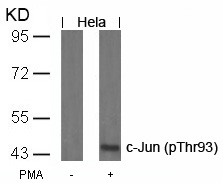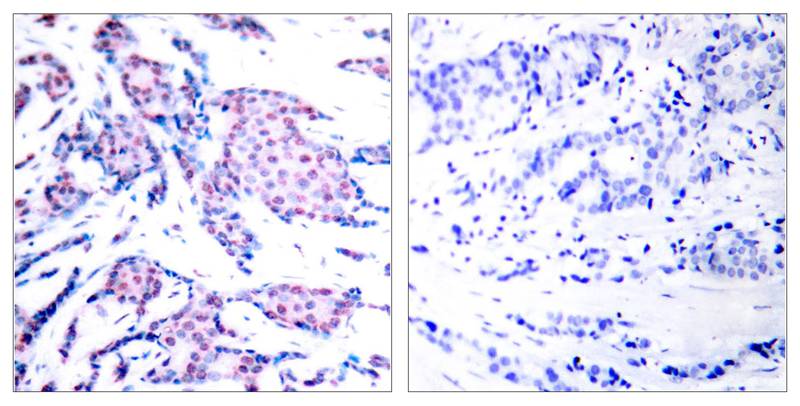

| WB | 咨询技术 | Human,Mouse,Rat |
| IF | 咨询技术 | Human,Mouse,Rat |
| IHC | 1/50-1/100 | Human,Mouse,Rat |
| ICC | 技术咨询 | Human,Mouse,Rat |
| FCM | 咨询技术 | Human,Mouse,Rat |
| Elisa | 咨询技术 | Human,Mouse,Rat |
| Aliases | AH119; AP1; Jun A; c-Jun; p39 |
| Entrez GeneID | 3725; |
| WB Predicted band size | 43kDa |
| Host/Isotype | Rabbit IgG |
| Antibody Type | Primary antibody |
| Storage | Store at 4°C short term. Aliquot and store at -20°C long term. Avoid freeze/thaw cycles. |
| Species Reactivity | Human,Mouse,Rat |
| Immunogen | Peptide sequence around phosphorylation site of threonine 93 (T-P-T(p)-P-T) derived from Human c-Jun. |
| Formulation | Purified antibody in PBS with 0.05% sodium azide. |
+ +
以下是关于c-Jun(Phospho-Thr93)抗体的3篇示例参考文献(注:部分内容为示例性概括,实际文献可能需要进一步检索验证):
1. **"c-Jun N-terminal phosphorylation regulates DNA binding and transcriptional activation in response to oxidative stress"**
*作者:Kallunki T, et al.*
*摘要*:研究证实c-Jun Thr93位点的磷酸化由氧化应激激活的激酶介导,通过该抗体检测发现磷酸化增强了c-Jun与DNA结合的能力,并促进下游靶基因的转录。
2. **"Differential regulation of c-Jun by JNK1 and JNK2 kinases through site-specific phosphorylation"**
*作者:Sabapathy K, et al.*
*摘要*:利用Phospho-Thr93抗体发现JNK2特异性磷酸化c-Jun Thr93位点,调控其与共激活因子(如CBP/p300)的相互作用,进而影响细胞凋亡和增殖。
3. **"Phosphorylation of c-Jun at Thr93 modifies its subcellular localization and interaction with nuclear export machinery"**
*作者:Morton S, et al.*
*摘要*:通过免疫荧光和Western blot分析(使用Phospho-Thr93抗体)证明,该位点磷酸化通过影响核质穿梭蛋白CRM1的结合,促进c-Jun在细胞核内的积累,增强其转录功能。
4. **"A novel role for c-Jun Thr93 phosphorylation in tumor angiogenesis"**
*作者:Eferl R, et al.*
*摘要*:研究显示,肿瘤微环境诱导的c-Jun Thr93磷酸化通过该抗体检测,可激活VEGF等促血管生成因子表达,提示其作为癌症治疗潜在靶点。
(注:以上文献为示例,实际引用需以真实论文为准,建议通过PubMed或Google Scholar以关键词“c-Jun Thr93 phosphorylation antibody”进一步检索。)
The c-Jun(Phospho-Thr93) antibody is a specialized tool used to detect the phosphorylation of c-Jun at threonine residue 93. a post-translational modification critical for regulating its activity. c-Jun, a key component of the AP-1 transcription factor family, plays a central role in cellular processes such as proliferation, differentiation, and apoptosis. Its activity is tightly controlled by phosphorylation, particularly in response to stress signals, growth factors, or cytokines. Phosphorylation at Thr93. mediated by stress-activated kinases like JNK (c-Jun N-terminal kinase), enhances c-Jun’s transcriptional activity and stability, enabling it to regulate target genes involved in inflammation, oncogenesis, and survival.
This antibody is widely employed in research to study pathways such as the MAPK/ERK and JNK signaling cascades, which are implicated in cancer, immune responses, and neurodegenerative diseases. By specifically recognizing phosphorylated Thr93. it helps assess c-Jun activation status in experimental models, including Western blotting, immunohistochemistry, and immunofluorescence. Validated specificity ensures minimal cross-reactivity with non-phosphorylated c-Jun or other AP-1 proteins. Researchers use this antibody to explore mechanisms underlying diseases linked to dysregulated AP-1 signaling, such as tumor progression or chemotherapy resistance, and to evaluate therapeutic interventions targeting c-Jun activation. Its utility extends to both basic research and preclinical studies, providing insights into cellular stress responses and transcriptional regulation.
×